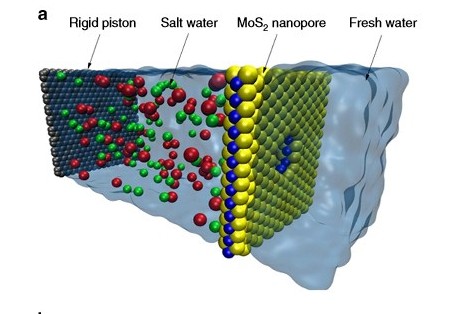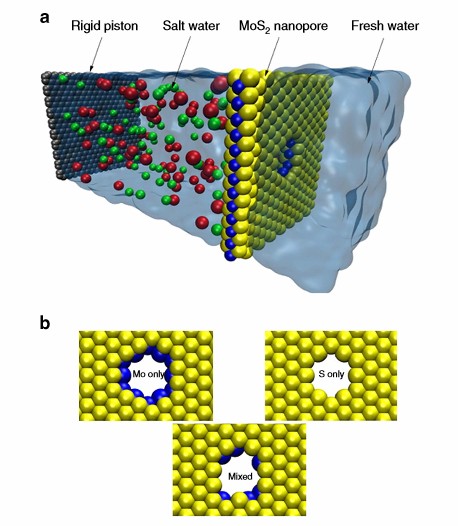November 21, 2015 – Back in February last year I wrote about a new desalination technology called shock electrodialysis using a membrane through which sodium and chlorine ions pass in the presence of an electrical charge and subsequently leaving fresh, purified water. The key to this technology was the membrane, a porous solid made from glass with pore sizes at 0.5 micrometers. In other words, small enough for the ions to pass but not for other impurities. This technology coming from Massachusetts Institute of Technology still needed to be taken from the laboratory and turned into a commercial venture.
Well move over MIT because University of Illinois has designed a filter material made from molybdenum disulfide (MoS2) that accomplishes similar results. The molybdenum in the filter attracts water while the sulfur on the other side of the filter pushes the water away creating a high rate of flow through the nanopore-sized holes. That means no electrical charge is needed to sustain the process. The inventors describe the filter as the first “thirsty” water filter. The researchers are confident that the technology can be upscaled for commercial use. If so MoS2 desalination could replace costly reverse osmosis systems, the current gold standard for commercial desalination. The additional advantage for the climate is this technology would be low-carbon in intensity when compared to current desalination plants.
The research results appear in the October 14, 2015 edition of the journal Nature Communications. The image below is a schematic representation of how the filter works. (a) shows the MoS2 sheet with the molybdenum in blue and the sulfur in yellow. Water appears transparent blue. In (b) we see three types of pores, one molybdenum only, one mixed and one sulfur only. The study tested all three types to determine relative performance. The membrane was compared with graphene-based rigid technology with better than 70% improvement. The molybdenum-only pores allowed the greatest flow-through rate but overall the MoS2 mix performed two to five times better than current conventional desalination technology.











